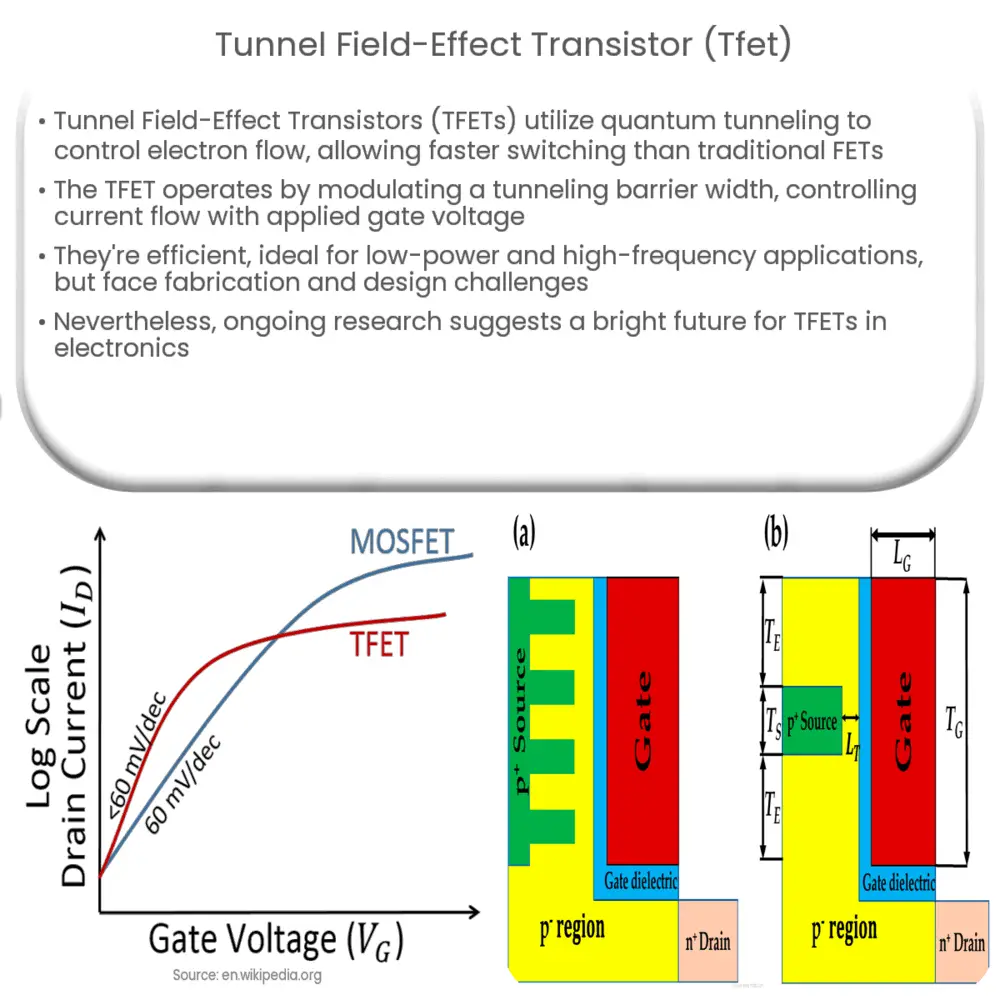Explore the world of Tunnel Field-Effect Transistors (TFETs): their working principle, advantages, applications, challenges, and future prospects.

Introduction to Tunnel Field-Effect Transistor (TFET)
The Tunnel Field-Effect Transistor (TFET) is a type of transistor that leverages the phenomenon of quantum tunneling to control the flow of electrons across a barrier. Unlike traditional Field-Effect Transistors (FETs), where conduction occurs due to thermal injection, in TFETs, current flows via the tunneling process.
This distinction gives TFETs a unique advantage over traditional transistors. Because they use tunneling—a process that is essentially instantaneous—they can switch on and off much faster than conventional FETs. This speed is a significant asset in high-frequency applications such as digital electronics.
Working Principle of Tunnel Field-Effect Transistor
The TFET operates by modulating the tunneling barrier width between the source and channel regions of the transistor. When a gate voltage is applied, it changes the band alignment at the source/channel interface, influencing the rate of electron tunneling and thus, controlling the current flow.
In the OFF state, the gate voltage is set such that the tunneling barrier is wide, impeding the flow of electrons. Conversely, in the ON state, the gate voltage is tuned to shrink the tunneling barrier, allowing a rapid flow of electrons.
Structural Composition of TFET
The TFET is built of a source, a drain, a gate, and a channel. The source and drain are typically made of highly doped semiconductors, while the channel, often an intrinsic or lightly doped semiconductor, connects them. The gate, which controls the operation of the device, is separated from the channel by an insulating layer, often made of high-k dielectric material.
- Source: This is the region from where carriers are injected into the channel. The source is heavily doped, with either p-type or n-type doping, depending on whether the TFET is p-type or n-type, respectively.
- Drain: The drain is the region where carriers exit the transistor. Like the source, the drain is also heavily doped, with the opposite type of doping to the source.
- Gate: The gate is the controlling terminal. By applying a voltage to the gate, we modulate the width of the tunneling barrier and control the flow of current.
- Channel: The channel is the region through which carriers move from source to drain. The conductivity of the channel is modulated by the gate voltage.
Advantages and Applications of TFET
TFETs have several advantages over traditional FETs. Most notably, they have a lower subthreshold swing, which is the rate at which the transistor turns on as the gate voltage increases. This lower subthreshold swing means TFETs can operate at lower voltages, making them very efficient and ideal for low-power applications. Their high switching speed also makes them suitable for high-frequency applications.
TFETs also offer better electrostatic control over the channel due to their wrapped gate structures, which helps in reducing leakage current and increasing device performance.
- Low Power Electronics: Due to their low operating voltages and high efficiency, TFETs are excellent for use in battery-operated devices, IoT devices, and other low power electronics.
- High Frequency Electronics: The high switching speeds of TFETs make them suitable for use in high-frequency applications like RF amplifiers and high-speed processors.
- Logic Gates: TFETs can be used to construct logic gates, the building blocks of digital circuits, leading to faster and more efficient digital systems.
Challenges and Future Prospects
Despite their numerous advantages, TFETs also face several challenges. One significant challenge is the difficulty in fabricating TFETs due to the need for ultra-thin and precisely controlled gate oxides. The design and manufacturing processes for TFETs are complex and require advanced techniques.
Another issue is the ambipolar behavior of TFETs, where both electrons and holes contribute to the conduction. This can lead to unwanted current flow and complicates the design process.
Despite these challenges, research in the field of TFETs is ongoing and promising. As fabrication processes advance and the understanding of tunneling phenomena improves, TFETs are expected to play a significant role in future electronic devices.
Conclusion
In conclusion, Tunnel Field-Effect Transistors (TFETs), with their unique mechanism based on quantum tunneling, offer several advantages over traditional FETs, including lower power consumption and faster switching speeds. Despite the challenges in fabrication and design, the potential applications of TFETs in low power and high-frequency electronics are vast. With ongoing research and development, TFETs are poised to contribute significantly to the future landscape of electronics.

